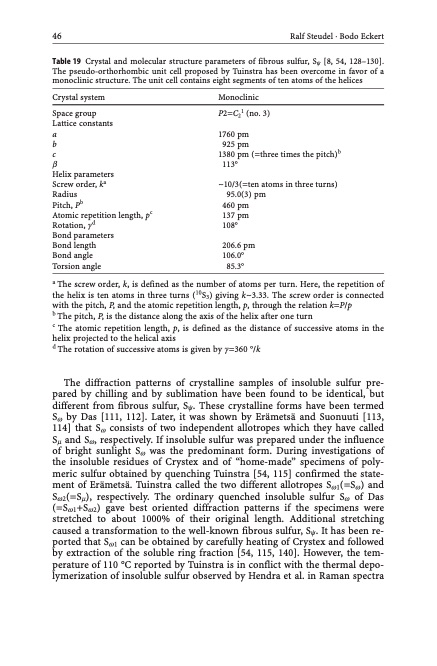
PDF Publication Title:
Text from PDF Page: 056
46 Ralf Steudel · Bodo Eckert Table 19 Crystal and molecular structure parameters of fibrous sulfur, Sy [8, 54, 128–130]. The pseudo-orthorhombic unit cell proposed by Tuinstra has been overcome in favor of a monoclinic structure. The unit cell contains eight segments of ten atoms of the helices Crystal system Space group Lattice constants a b c b Helix parameters Screw order, ka Radius Pitch, Pb Atomic repetition length, pc Rotation, gd Bond parameters Bond length Bond angle Torsion angle Monoclinic P2=C21 (no. 3) 1760 pm 925 pm 1380 pm (=three times the pitch)b 113 ~10/3(=ten atoms in three turns) 95.0(3) pm 460 pm 137 pm 108 206.6 pm 106.0 85.3 a The screw order, k, is defined as the number of atoms per turn. Here, the repetition of the helix is ten atoms in three turns (10S3) giving k~3.33. The screw order is connected with the pitch, P, and the atomic repetition length, p, through the relation k=P/p b The pitch, P, is the distance along the axis of the helix after one turn c The atomic repetition length, p, is defined as the distance of successive atoms in the helix projected to the helical axis d The rotation of successive atoms is given by g=360 /k The diffraction patterns of crystalline samples of insoluble sulfur pre- pared by chilling and by sublimation have been found to be identical, but different from fibrous sulfur, Sy. These crystalline forms have been termed Sw by Das [111, 112]. Later, it was shown by Erämetsä and Suonuuti [113, 114] that Sw consists of two independent allotropes which they have called Sm and Sw, respectively. If insoluble sulfur was prepared under the influence of bright sunlight Sw was the predominant form. During investigations of the insoluble residues of Crystex and of “home-made” specimens of poly- meric sulfur obtained by quenching Tuinstra [54, 115] confirmed the state- ment of Erämetsä. Tuinstra called the two different allotropes Sw1(=Sw) and Sw2(=Sm), respectively. The ordinary quenched insoluble sulfur Sw of Das (=Sw1+Sw2) gave best oriented diffraction patterns if the specimens were stretched to about 1000% of their original length. Additional stretching caused a transformation to the well-known fibrous sulfur, Sy. It has been re- ported that Sw1 can be obtained by carefully heating of Crystex and followed by extraction of the soluble ring fraction [54, 115, 140]. However, the tem- perature of 110 C reported by Tuinstra is in conflict with the thermal depo- lymerization of insoluble sulfur observed by Hendra et al. in Raman spectraPDF Image | Topics in Current Chemistry

PDF Search Title:
Topics in Current ChemistryOriginal File Name Searched:
Elemental-Sulfur-und-Sulfur-Rich-Compounds-I.pdfDIY PDF Search: Google It | Yahoo | Bing
Sulfur Deposition on Carbon Nanofibers using Supercritical CO2 Sulfur Deposition on Carbon Nanofibers using Supercritical CO2. Gamma sulfur also known as mother of pearl sulfur and nacreous sulfur... More Info
CO2 Organic Rankine Cycle Experimenter Platform The supercritical CO2 phase change system is both a heat pump and organic rankine cycle which can be used for those purposes and as a supercritical extractor for advanced subcritical and supercritical extraction technology. Uses include producing nanoparticles, precious metal CO2 extraction, lithium battery recycling, and other applications... More Info
| CONTACT TEL: 608-238-6001 Email: greg@infinityturbine.com | RSS | AMP |